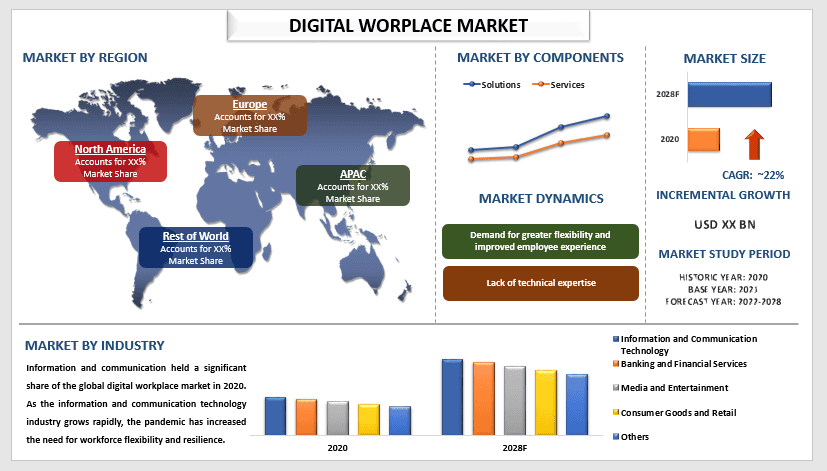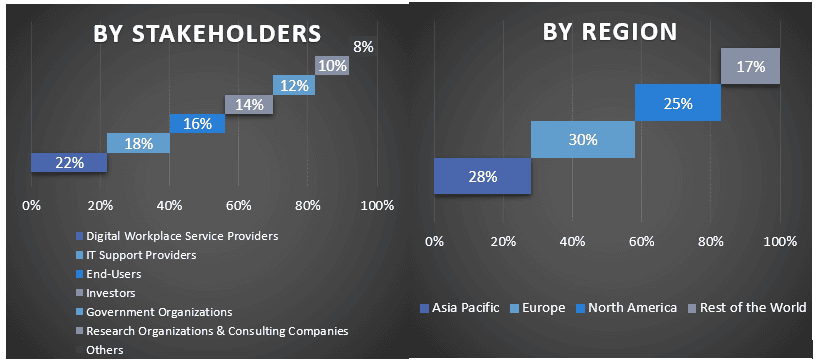- Home
- Chi siamo
- Settore
- Servizi
- Lettura
- Contattaci
Mercato del Digital Workplace: Analisi attuale e previsioni (2022-2028)
Enfasi sui Componenti (Soluzioni e Servizi); Dimensione Organizzativa (Grandi Imprese e PMI); Settore (Tecnologia dell'Informazione e della Comunicazione, Servizi Bancari e Finanziari, Media e Intrattenimento, Beni di Consumo e Vendita al Dettaglio e Altri); e Regione/Paese

Si prevede che il mercato globale del Digital Workplace crescerà a un tasso di crescita di circa il 22% durante il periodo di previsione. Il mercato globale del digital workplace sta crescendo rapidamente a causa della crescente domanda di una maggiore flessibilità in termini di equilibrio tra lavoro e vita privata tra i dipendenti, della crescente domanda di desktop-as-a-service e della migliore esperienza dei dipendenti attraverso uno stile di lavoro più semplice e flessibile. Uno spazio di lavoro virtuale è uno spazio di lavoro che non si trova in uno spazio fisico. In genere, si tratta di una rete di più luoghi di lavoro collegati tecnicamente indipendentemente dai confini geografici. I dipendenti possono quindi interagire in un ambiente collaborativo indipendentemente dalla loro posizione. Inoltre, una maggiore digitalizzazione e una crescente adozione del cloud computing stanno ulteriormente influenzando la crescita del mercato del digital workplace. Ad esempio, secondo Eurostat, nel 2020 il 36% delle imprese nell'Unione Europea utilizzava servizi di cloud computing, ma nel 2021 il 41% delle imprese utilizzava servizi di cloud computing.
Atos SE, Cognizant Technology Solutions, International Business Machines Corporation, Zenstar Computer Solutions, Wipro Limited, Infosys Limited, Accenture plc, Fujitsu Limited, HCL Technologies e DXC Technology sono alcuni dei principali attori del mercato. Diverse fusioni e acquisizioni insieme a partnership sono state intraprese da questi attori per facilitare i clienti con prodotti/tecnologie hi-tech e innovativi.
Approfondimenti presentati nel rapporto
"Tra le dimensioni dell'organizzazione, il segmento delle grandi imprese registrerà un robusto CAGR durante il periodo di previsione"
Per dimensione dell'organizzazione, il mercato del digital workplace è suddiviso in grandi imprese e PMI. Le grandi imprese hanno soddisfatto una quota significativa del mercato. Questo perché molte grandi aziende stanno abbracciando tecnologie facili da usare, cloud e innovative, supportate dall'intelligenza artificiale e da altre tecnologie e software di automazione. Implementando una strategia di digital workplace, le aziende possono ottenere una maggiore flessibilità, costi ottimizzati e servizi, processi ed esperienza dei dipendenti migliorati. Inoltre, può anche aiutare a ottenere una migliore esperienza del cliente e un processo decisionale esecutivo.
"Tra i settori, il segmento dell'information and communication technology deterrà una quota significativa del mercato nel 2020"
In base al settore, il mercato è suddiviso in information and communication technology, servizi bancari e finanziari, media e intrattenimento, beni di consumo e vendita al dettaglio e altri. L'information and communication technology ha detenuto una quota significativa del mercato globale del digital workplace nel 2020. Mentre il settore dell'information and communication technology cresce rapidamente, la pandemia ha aumentato la necessità di flessibilità e resilienza della forza lavoro. Le organizzazioni stanno investendo in modo aggressivo in soluzioni digitali per gestire le proprie attività e creare resilienza contro blocchi senza precedenti.
"Il Nord America deterrà una quota significativa del mercato"
Nel 2020, il Nord America deteneva una quota significativa del mercato globale del digital workplace. Questo perché il Nord America ospita le principali aziende che operano nel settore dell'information and communication technology e nei servizi bancari e finanziari. Inoltre, il Nord America è il mercato più maturo per l'adozione di soluzioni e servizi di digital workplace. La regione è un hub per varie piccole imprese, start-up e medie e grandi imprese. Significa il passaggio a comunicazioni gateway sicure per l'Internet of Things (IoT), l'adozione di tecnologie come l'intelligenza artificiale (AI), la realtà aumentata (AR), l'automazione robotica dei processi (RPA) e l'aumento della collaborazione sociale al di fuori dell'impresa. Pertanto, la domanda di digital workplace è elevata in Nord America.
Motivi per acquistare questo rapporto:
- Lo studio include l'analisi delle dimensioni del mercato e delle previsioni convalidate da esperti chiave del settore autenticati.
- Il rapporto presenta una rapida revisione delle prestazioni complessive del settore a colpo d'occhio.
- Il rapporto copre un'analisi approfondita dei principali concorrenti del settore con un focus primario sui principali dati finanziari aziendali, portafogli di prodotti, strategie di espansione e sviluppi recenti.
- Esame dettagliato dei driver, dei vincoli, delle tendenze chiave e delle opportunità prevalenti nel settore.
- Lo studio copre in modo completo il mercato attraverso diversi segmenti.
- Analisi approfondita a livello regionale del settore.
Opzioni di personalizzazione:
Il mercato globale del digital workplace può essere ulteriormente personalizzato in base alle esigenze o a qualsiasi altro segmento di mercato. Inoltre, UMI comprende che potresti avere le tue esigenze aziendali, quindi sentiti libero di metterti in contatto con noi per ottenere un rapporto che si adatti perfettamente alle tue esigenze.
Indice
Metodologia di ricerca per l'analisi del mercato del Digital Workplace (2022-2028)
L'analisi del mercato storico, la stima del mercato attuale e la previsione del mercato futuro del mercato globale del digital workplace sono stati i tre passaggi principali intrapresi per creare e analizzare l'adozione del digital workplace nelle principali regioni a livello globale. È stata condotta un'esauriente ricerca secondaria per raccogliere i dati storici del mercato e stimare le dimensioni attuali del mercato. In secondo luogo, per convalidare queste intuizioni, sono stati presi in considerazione numerosi risultati e ipotesi. Inoltre, sono state condotte anche esaurienti interviste primarie con esperti del settore lungo tutta la catena del valore del mercato globale del digital workplace. Dopo l'ipotesi e la convalida dei dati di mercato attraverso interviste primarie, abbiamo impiegato un approccio top-down/bottom-up per prevedere la dimensione completa del mercato. Successivamente, sono stati adottati metodi di scomposizione del mercato e triangolazione dei dati per stimare e analizzare le dimensioni del mercato dei segmenti e sottosegmenti del settore di riferimento. La metodologia dettagliata è spiegata di seguito:
Analisi delle dimensioni storiche del mercato
Passaggio 1: Studio approfondito delle fonti secondarie:
È stato condotto uno studio secondario dettagliato per ottenere le dimensioni storiche del mercato del digital workplace attraverso fonti interne aziendali come relazioni annuali e bilanci, presentazioni sulle prestazioni, comunicati stampa, ecc., e fonti esterne tra cui riviste, notizie e articoli, pubblicazioni governative, pubblicazioni della concorrenza, rapporti di settore, database di terze parti e altre pubblicazioni credibili.
Passaggio 2: Segmentazione del mercato:
Dopo aver ottenuto le dimensioni storiche del mercato del digital workplace, abbiamo condotto un'analisi secondaria dettagliata per raccogliere informazioni storiche sul mercato e condividerle per diversi segmenti e sottosegmenti per le principali regioni. I segmenti principali inclusi nel rapporto sono componenti, dimensioni dell'organizzazione e settore. Sono state condotte ulteriori analisi a livello di paese per valutare l'adozione complessiva dei modelli di test in quella regione.
Passaggio 3: Analisi dei fattori:
Dopo aver acquisito le dimensioni storiche del mercato di diversi segmenti e sottosegmenti, abbiamo condotto una dettagliata analisi dei fattori per stimare le dimensioni attuali del mercato del digital workplace. Inoltre, abbiamo condotto un'analisi dei fattori utilizzando variabili dipendenti e indipendenti come componenti, dimensioni dell'organizzazione e settore del digital workplace. È stata condotta un'analisi approfondita per scenari lato domanda e offerta considerando le principali partnership, fusioni e acquisizioni, espansioni aziendali e lanci di prodotti nel settore del mercato del Digital Workplace in tutto il mondo.
Stima e previsione delle dimensioni attuali del mercato
Dimensionamento attuale del mercato: Sulla base di informazioni utili derivanti dai 3 passaggi precedenti, siamo giunti alle dimensioni attuali del mercato, ai principali attori nel mercato globale del digital workplace e alle quote di mercato dei segmenti. Tutte le quote percentuali richieste e le scomposizioni del mercato sono state determinate utilizzando l'approccio secondario sopra menzionato e sono state verificate attraverso interviste primarie.
Stima e previsione: Per la stima e la previsione del mercato, sono stati assegnati pesi a diversi fattori tra cui driver e tendenze, vincoli e opportunità disponibili per le parti interessate. Dopo aver analizzato questi fattori, sono state applicate tecniche di previsione pertinenti, ovvero l'approccio top-down/bottom-up, per arrivare alla previsione di mercato per il 2027 per diversi segmenti e sottosegmenti nei principali mercati a livello globale. La metodologia di ricerca adottata per stimare le dimensioni del mercato comprende:
- Le dimensioni del mercato del settore, in termini di ricavi (USD) e il tasso di adozione del mercato del digital workplace nei principali mercati a livello nazionale
- Tutte le quote percentuali, le divisioni e le ripartizioni dei segmenti di mercato e dei sottosegmenti
- I principali attori nel mercato globale del digital workplace in termini di prodotti offerti. Inoltre, le strategie di crescita adottate da questi attori per competere nel mercato in rapida crescita
Convalida delle dimensioni e della quota di mercato
Ricerca primaria: Sono state condotte interviste approfondite con i Key Opinion Leaders (KOL) tra cui Top Level Executives (CXO/VP, Sales Head, Marketing Head, Operational Head, Regional Head, Country Head, ecc.) nelle principali regioni. I risultati della ricerca primaria sono stati quindi riassunti ed è stata eseguita un'analisi statistica per dimostrare l'ipotesi dichiarata. Gli input della ricerca primaria sono stati consolidati con i risultati secondari, trasformando quindi le informazioni in intuizioni utilizzabili.
Ripartizione dei partecipanti primari nelle diverse regioni

Ingegneria del mercato
La tecnica di triangolazione dei dati è stata impiegata per completare la stima complessiva del mercato e per arrivare a numeri statistici precisi per ciascun segmento e sottosegmento del mercato globale del digital workplace. i dati sono stati suddivisi in diversi segmenti e sottosegmenti dopo aver studiato vari parametri e tendenze nelle aree di componenti, dimensioni dell'organizzazione e settore nel mercato globale del digital workplace.
L'obiettivo principale dello studio sul mercato globale del Digital Workplace
Le tendenze di mercato attuali e future del mercato globale del digital workplace sono state individuate nello studio. Gli investitori possono ottenere informazioni strategiche per basare la propria discrezione per gli investimenti sull'analisi qualitativa e quantitativa eseguita nello studio. Le tendenze di mercato attuali e future hanno determinato l'attrattiva complessiva del mercato a livello regionale, fornendo una piattaforma per il partecipante industriale per sfruttare il mercato non sfruttato per beneficiare di un vantaggio di first-mover. Altri obiettivi quantitativi degli studi includono:
- Analizzare le dimensioni del mercato attuale e previsto del mercato del digital workplace in termini di valore (USD). Inoltre, analizzare le dimensioni del mercato attuale e previsto di diversi segmenti e sottosegmenti
- I segmenti nello studio includono le aree di componenti, dimensioni dell'organizzazione e settore
- Definire e analizzare il quadro normativo per il settore del digital workplace
- Analizzare la catena del valore coinvolta con la presenza di vari intermediari, insieme all'analisi dei comportamenti dei clienti e della concorrenza del settore
- Analizzare le dimensioni del mercato attuale e previsto del mercato del digital workplace per la regione principale
- I principali paesi delle regioni studiate nel rapporto includono Asia Pacifico, Europa, Nord America e il resto del mondo
- Profili aziendali del mercato del digital workplace e le strategie di crescita adottate dagli attori del mercato per sostenersi nel mercato in rapida crescita
- Analisi approfondita a livello regionale del settore
Correlati Report
I clienti che hanno acquistato questo articolo hanno acquistato anche










